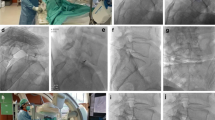Abstract
Purpose
To retrospectively assess safety and potential effectiveness of percutaneous intervertebral disc coagulation therapy (PDCT) using plasma thermal reaction for the treatment of lumbar and cervical disc hernias resistant to medical therapy.
Materials and Methods
Forty-four patients (age range 18–87 years, mean 52.7) with contained and extruded symptomatic lumbar (N = 48) and cervical (N = 6) disc hernias in the absence of free fragments causing radiculopathy without improvement after 6-week conservative therapy were enrolled. Pretreatment discography has been performed in every patient. Spine MRI was performed before the procedure and 4 months later, in order to check post-PDCT changes. Technical success was defined as correct placement of PDCT fiber; clinical outcomes were evaluated using visual analog scale (VAS) and the Oswestry Disability Index (ODI) before the procedure and after 4 months.
Results
A total of 54 levels have been treated with 98% technical success; in 12 patients (27%), the treatment was performed in two levels at the same time. All patients well tolerated the procedure; most patients (N = 39; 89%) had significant improvement in symptoms, with ODI score reduction from 47.61 ± 8.7 to 13.38 ± 9.4 (p < 0.001). The mean pre-PDCT VAS score was 7.47 ± 0.8. VAS score was decreased down to 1.36 ± 1.6 at final follow-up (p < 0.001). There were no cases of infection, nerve damage, or bleeding.
Conclusions
PDCT can be an effective and safe for minimally invasive indirect decompression for cervical and lumbar hernia resistant to conservative treatment, particularly when patients are correctly selected.






Similar content being viewed by others
References
Kaye AD, Manchikanti L, Abdi S, et al. Efficacy of epidural injections in managing chronic spinal pain: a best evidence synthesis. Pain Physician. 2015;18:E939–1004.
Kelekis AD, Filippiadis DK, Martin JB, Brountzos E. Standards of practice: quality assurance guidelines for percutaneous treatments of intervertebral discs. Cardiovasc Interv Radiol. 2010;33:909–13.
Côté P, Cassidy JD, Carroll LJ, Kristman V. The annual incidence and course of neck pain in the general population: a population-based cohort study. Pain. 2004;112:267–73.
Kreiner DS, Hwang SW, Easa JE, et al. An evidence-based clinical guideline for the diagnosis and treatment of lumbar disc herniation with radiculopathy. Spine J. 2014;14:180–91.
German JV, Adamo MA, Hoppenot RG, Blossom JH, Nagle HA. Perioperative results following lumbar discectomy: comparison of minimally invasive discectomy and standard microdiscectomy. Neurosurg Focus. 2008;25:F20.
Alò KM, Wright RE, Sutcliffe J, Brandt SA. Percutaneous lumbar discectomy: one-year follow-up in an initial cohort of fifty consecutive patients with chronic radicular pain. Pain Pract. 2005;5:116–24.
Slipman CW, Bender FJ III, Menkin S, Garvan C, Salam A, Siegelman E. Percutaneous lumbar disk decompression using the dekompressor: a pilot study. Arch Phys Med Rehabil. 2006;87:e21.
Galluci M, Limbucci N, Paonessa A, Splendiani A. Degenerative disease of the spine. Neuroimaging Clin N Am. 2007;17:87–103.
Filippiadis DK, Kelekis A. A review of percutaneous techniques for low back pain and neuralgia: current trends in epidural infiltrations, intervertebral disk and facet joint therapies. Br J Radiol. 2016; 89:1057.
Kim SH, Kim SC, Cho KH. Clinical outcomes of percutaneous plasma disc coagulation therapy for lumbar herniated disc disease. J Korean Neurosurg. 2012;51:8–13.
Gerszten PC, Smuck M, Rathmell JP, et al. Bloch and the SPINE Study Group Plasma disc decompression compared with fluoroscopyguided transforaminal epidural steroid injections for symptomatic contained lumbar disc herniation:a prospective, randomized, controlled trial. J Neurosurg Spine 2015;12: 357– 371.
Yucetas Seyho C, Gezgin Inan, Yildirim Can H, Ehi Yusuf, Kaya Miktat. Evaluation of long-term clinical results of percutaneous plasma disk coagulation treatment in lumbar and cervical disk herniation. Neurosurg Q. 2016;26:219–24.
Kelekis A, Filippiadis DK. Percutaneous treatment of cervical and lumbar herniated disc. Eur J of Radiol. 2015;84:771–6.
Moore Jeffrey A, Albert Todd J, Radcliff Kris. The value and cost-effectiveness of adult degenerative lumbar surgery. Semin Spine Surg. 2014;26:38–44.
Acknowledgments
We thank Prof. Alessandro Rossi, chief of the Neurologic and Motor Sciences Department (“Santa Maria alle Scotte” University Hospital, Siena, Italy), for his invaluable help and comments.
Author information
Authors and Affiliations
Corresponding author
Ethics declarations
Conflict of interest
The authors declare that they have no conflict of interest.
Informed Consent
For the present study formal consent is not required; for this type of study informed consent is not required. Privacy consent was obtained for every individual person’s data included in the study; for this type of study consent for publication is not required.
Additional information
Publisher's Note
Springer Nature remains neutral with regard to jurisdictional claims in published maps and institutional affiliations.
Rights and permissions
About this article
Cite this article
Zini, C., Notaro, D., Sadotti, G. et al. Percutaneous Intervertebral Disc Coagulation Therapy (PDCT) by Plasma Light: Preliminary Data from the First Experience in Europe. Cardiovasc Intervent Radiol 43, 94–102 (2020). https://doi.org/10.1007/s00270-019-02306-6
Received:
Revised:
Accepted:
Published:
Issue Date:
DOI: https://doi.org/10.1007/s00270-019-02306-6




